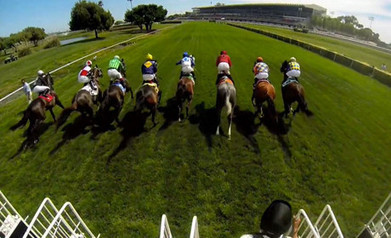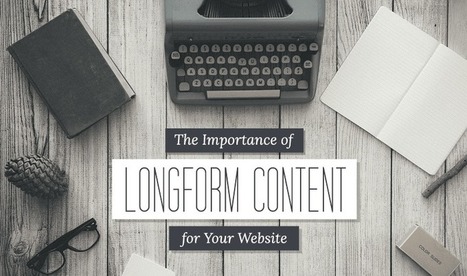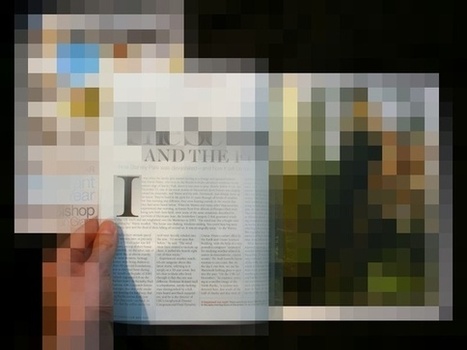 Your new post is loading...
 Your new post is loading...
Pew Research Center, in association with the John S. and James L. Knight Foundation, wanted to explore how the rise in mobile devices impacted long-form content. Using anonymized data from Parse.ly’s database of hundreds of news and media sites, it was able to analyze this trend.
Report Findings: People Read Long-Form Content On Phones
It turns out that long-form journalism does have a place in today’s mobile-centric society.
“These findings suggest that on small, phone-sized screens the public does not automatically turn away from an article at a certain point in time – or reject digging into a longer-length news article. Instead, the average user tends to stay engaged past the point of where short-form reading would end, suggesting that readers may be willing to commit more time to a longer piece of work,” said Amy Mitchell, Pew Research Center’s director of journalism research.
Some highlights of the report include:
- Long-form stories attract visitors at nearly the same rate as short-form stories.
- Across all five distinct parts of the day, readers spend about twice the time with long-form news content on their cellphones as with short-form.
- No matter how readers arrive at specific content (through a link from an external website, social media, search, etc.), engaged time for long-form content regularly extends beyond that of short-form content.
These findings hold true even for individual digital publishers. For example, Lehigh University, a member of Parse.ly’s University Partnerships program, recently completed a study on reader engagement with long-form content. Editors at Lehigh’s student newspaper, The Brown & White, found that readers spend about the same amount of time on all pieces of content, relative to the length of an article.
The Big Roundtable exists to provide a home for what lately has been called “longform” journalism, and what we like to call nonfiction short stories...
....The two most widely read and shared feature stories BuzzFeed ran this year were about a 28-year-old box-office bomb and an 85-year-old exiled Chinese AIDS activist. The only thing they had in common was that they didn’t really exist in any form before. Also, though, they were good. The Internet is very big, so if you’re asking for the commitment that a longer story demands, and the personal guarantee that comes when a reader shares a long feature on Facebook or Twitter, you better deliver something worthy of that time.
We’ve published fifty or so of these long features since I started as BuzzFeed’s “longform editor” last November, all varying wildly in tone and content and intention. What they have in common is that they were all developed deliberately and methodically, with attention to presentation as much as structure. They are built as any magazine feature would have been built, only without the magazine part. They’re built for the Internet, to find their own audiences—not to hit a specific magazine’s voice or imagined reader. They are part of a first generation of attempts to bring the depth and rigor of great narrative journalism to a new medium and distribution system that has to figure out its capabilities and possibilities in real time....
When readers started moving to the internet, media analysts thought longform journalism was in trouble. Attention spans were going to shrivel. Readers wanted short, they wanted snappy, they wanted 140 characters and not much more (though a listicle on the side couldn’t hurt). Who would want to scroll through an 8,000-word article on an iPhone screen?
A good number of people, as it turned out. Longform has gone digital and is thriving. BuzzFeed has a longform editor, and longform aggregate website Longreads is partnering with The Atlantic. Stories like The New York Times’ “Snow Fall” have blended text with sleek visuals and multimedia.It’s not certain where longform is going, but a conference at Columbia’s Journalism School on Friday attempted to hazard a guess. The Future of Digital Longform, hosted by the school’s Tow Center for Digital Journalism, covered the questions emerging as longform shifts from paper to screen: “Is form following function, or is the medium cannibalizing the message?” “How can you maintain quality control?” And, of course, “How do you make money?”...
We speak to two of the people involved in creating the news outlet's latest Snowfall-like immersive multimedia project....
Last week The New York Times website published a story called The Jockey, followed by publication in the sports section of the print edition on Sunday.
The Jockey is the latest immersive or multimedia reading experience created by the news outlet that brought us Snow Fall. The Jockey tells the story of Russell Baze, the first North American jockey to ride in 50,000 races, and does so through long-form text, video and moving graphics.This immersive story has a sponsor. Some have interpreted this as native advertising or sponsored content, and AdAge writes that these custom ad units are "designed to better fit the new environment" than the advertising within Snow Fall...-
While long-form journalism's 'resurgence' may be over-hyped, technology is changing how people access it. Over the past year or so, a number of high-profile and prominent journalists and technologists have launched new apps, sites and other ventures dedicated to cultivating lengthy works of journalism. These projects — like The Atavist, Byliner, Longform.org, Longreads.com, Readability and others — are being credited with reviving a dead or near-dead art. But the obituary for long-form journalism was actually never written, according to some alt-weekly editors....
|
In recent months a debate has been brewing around whether shortform or longform content is winning the race for people’s attention. No doubt there are merits to both sides, but there seems to be some confusion abound the subject.
For clarity, longform means articles, white papers and e-books of 2,000 words or more, while shortform refers to content of 500 to 1,000 words.
Is there really a difference in their overall performances? Science suggests there is.
What the Studies Are Suggesting
Many of today’s Internet marketers swear by shortform content, citing a number of independent studies that indicate audience attention spans are falling and as much as 32 percent of users will begin abandoning websites in as little as five seconds if they are slow to load.
This doesn’t speak to the effectiveness of the format in reaching its audience in terms of visibility and findability through search. This is one of the most important advantages that longform content has over its counterpart....
When it comes to great magazine writing, what’s in a name?
I have had it with long-form journalism. By which I mean—don’t get me wrong—I’m fed up with the term long-form itself, a label that the people who create and sell magazines now invariably, and rather solemnly, apply to their most ambitious work. Reader, do you feel enticed to plunge into a story by the distinction that it is long? Or does your heart sink just a little? Would you feel drawn to a movie or a book simply because it is long? (“Oooh—you should really read Moby-Dick—it’s super long.”) Journalists presumably care about words as much as anyone, so it is mysterious that they would choose to promote their stories by ballyhooing one of their less inherently appealing attributes. Do we call certain desserts “solid-fat-form food” or do we call them cakes and pies? Is baseball a long-form sport? Okay, sure—but would Major League Baseball ever promote it as that? So why make a ripping yarn or an eye-popping profile sound like something you have to file to the IRS?.
Eric Schmidt has seen the future of magazines, and it's on the tablet....
...Five years from now, the world will have "powerful, tablet-looking things — [devices] that look roughly like a tablet — as a substitute for traditional media," Schmidt predicted. Those tablets will have apps that are "incredibly immersive," including magazine apps, which will take advantage of people's social graphs, location data and other features to offer a more interactive experience, he said....
"Hi is a website that lets you attach a snippet of text and a photograph to a location. We call that a moment. Moments are grouped by location. You can then choose to return to that moment later and extend it — write 100 or 10,000 words about it. That collection — moments tied to location, some short, some extended — is a narrative mapping."
Via Marie-Sophie
|



 Your new post is loading...
Your new post is loading...




















Pew Research Center found that longform content can work on mobile.